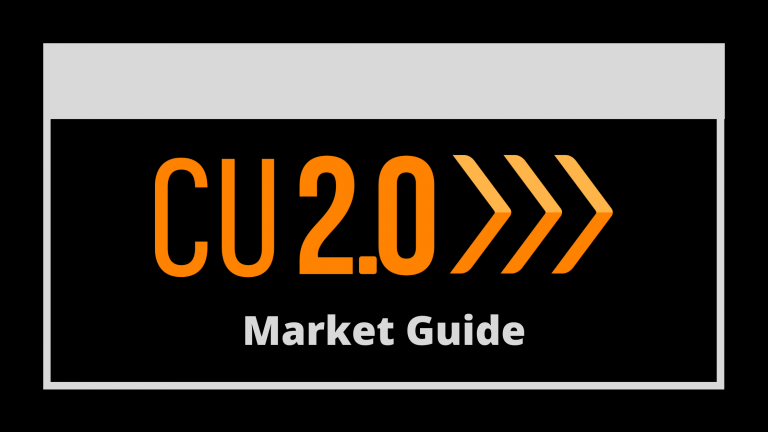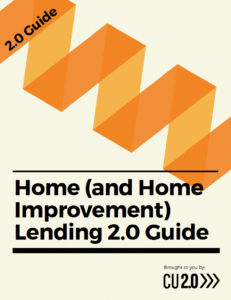Credit unions have stepped up for small businesses during the pandemic. They should continue the trend.
This Small Business Lending 2.0 Guide will give you context and insight about market trends, consumer behavior, and peer benchmarks. By the end of the guide, you should have a better understanding of the support that small businesses need—and you’ll learn about new fintechs that can help you lend to them.
This is a limited version of the guide—download the full version here!
Small business lending changed significantly in 2020.
This is due largely to two factors:
First, with the introduction of the CARES Act and PPP lending, hundreds of banks and credit unions joined the small business lending ecosystem and provided a lifeline to their professional communities.
Second, digital transformation (in every industry) got a huge injection of energy with massive work-from-home policies. Remote work accelerated adoption of web- and mobile-based delivery, including small business lending.
Both of these factors kicked off a footrace between fintechs and credit unions to see who could better support small businesses through lending. This guide will provide an overview on the state of small business lending fintech opportunities in the United States.
Contents of this guide:
- Market Assessment and Key Trends
- Credit Union Self-Assessment Framework of SMB Lending 2.0 Programs
- Fintech Integration Model
- Small Business Lending 2.0 Fintech List and Rankings
- Time Frame and Predictions of Market Direction
- Conclusions
Market Assessment and Key Trends
As of 2018, only 178 credit unions, or 3% of all credit unions even offered small business lending. Credit unions issued only 1.2% of all SBA loans. Small businesses borrow over $600 billion per year.
Clearly, there’s an opportunity here.
Key trends for this space include:
- Lower interest rates for the foreseeable future
- Fintech boom with lots of new entrants
- Growing use of AI (check out Financial—an AI guide for financial institutions)
- Faster decisioning and issuing (leveraging digital tools)
- Use of alternative credit scoring tools and approaches
- Use of blockchain and distributed ledger technology
- Improved mobile and digital delivery and customer expectations
In addition, prior to COVID-19, the SBA was already focused on getting more community financial institutions involved in small business lending. During COVID-19, small businesses had trouble accessing government recovery loans through regional or national banks. These SMBs turned to other financial institutions for approval.
Credit unions played a large role in helping these small businesses. Demand has increased as SMBs are looking for more working capital and assistance in bridging this challenging time period. The good news is that a significant portion of this demand can be met through existing SBA and USDA loans.
At its core, “Main Street” lending and small businesses are huge economic drivers for the US economy and our communities.
The added benefit for credit unions flush with liquidity? The rates on these loans are higher. And if done through the SBA, they’re guaranteed!
Self-Assessment Framework
BENCHMARK YOUR CHECKING PERFORMANCE
Do you lead the market? Do other credit unions and financial institutions measure themselves against you? Or do you have some catching up to do?
Download the full guide to complete the self-assessment framework and benchmarking!
Some credit unions have been doing small business or commercial lending for years. Many more are new to the game (due in part to the PPP Program), and they’re seeing the value and opportunity to help their communities.
The reality is that most credit unions still don’t have a strategy for small business lending. Even existing programs lack a clear mission. Credit unions often offer small business lending as a “me too” service instead of having a defined strategy for the community. And there’s a reason for that:
Building strategy for a credit union is often challenging because credit unions are stretched thin on resources, expertise, etc. Frequently, they struggle to define a competitive offering that positions them as a lending expert (or primary choice) in their communities.
Yet, by simply claiming this position, they could further help their communities through job creation, increased tax revenue, and providing truly transformational growth opportunities and support for the small businesses in their communities. Of course, this is a long-term strategy that will take years to realize, but it can lead to huge, sustained growth for the credit union and its members.
Here is a quick rating system for credit unions to evaluate where they are in the small business lending cycle. Once you know where you are, it’s time to define a strategy to take your credit union and community to the next level!
Small Business Lending Market Assessment Model

Download the guide to map your progress on this chart!
Basic Strategy for Small Business Lending for Credit Unions
Generally, there are three pillars of small business lending:
- Digital small business lending. This pillar supports small businesses with dynamic, standardized application processes. It should be flexible enough to accommodate the various ways that members make money. As you may have guessed, this pillar means providing digital tools and resources to make this process easy!
- Product offering tool kit. The credit unions that adapted to the pandemic were able to quickly deploy PPP programs and add critical net income in 2020 to offset future loan losses. Having a technology stack or partner that can pivot quickly is essential. Being able to change to local market fluctuations and trends is essential.
- Analytics, analytics, analytics. Credit unions must be able to aggregate lending and small business data from places like QuickBooks, Plaid, Square etc. It’s crucial to truly paint the economic viability picture of the small business. But nobody has time to build custom spreadsheets and find every receipt. So, pick or offer a toolkit that allows for efficient data aggregation, reporting, and portfolio management.
Download the full guide to determine how effective your small business lending strategy is today.

Self-Assessment Scoring Rubric
The following questions provide a framework by which to evaluate your performance for Digital SMB, Product Offering, and Analytics.
Go ahead and rate yourself to determine how effective your small business lending strategy is today. Your average score for each category will correspond to the SMB Lending Assessment Model on the previous page.
| Key Tech | Overview | Self-Assessment Score (1–10) |
| Online Application
(Digital SMB) |
Do you offer an online application for small businesses to apply easily and quickly with minimal information? Is it web and mobile accessible (not a PDF!)? | |
| Intuitive UI
(Digital SMB) |
Can borrowers navigate the application process without speaking to a representative? Can it be completed in a single session? | |
| Electronic Paperwork
(Digital SMB) |
Can everything be done electronically, including closing, without a physical signature? | |
| Automated Decisioning
(Digital SMB) |
Can your system make a go / no go decision within key limits quickly? Does it require human intervention? Can your system quickly evaluate income, expenses, and more to let the borrower know you have them covered quickly? | |
| Speed of Underwriting
(Digital SMB) |
How quickly can you make a decision? Does it have to go to a loan committee that meets monthly? Can you keep pace with the fintech world, which operates much faster and approves in minutes instead of hours or days? | |
| Loan Terms
(Digital SMB) |
Does your platform offer flexible loan terms? Can borrowers choose from different repayment options to best fit their business’s needs? | |
| Loan Amounts
(Product Offering) |
Does your lending program provide options for borrowers? Can they take out very small or very large loans, or are they within a narrow range? | |
| Servicing
(Product Offering) |
What are the servicing tools like? Are they built for NCUA and SBA compliance and guidelines? Do they protect you to make sure that if there’s a default, your guarantee holds? | |
| Lending Flexibility
(Product Offering) |
Does your SMB lending platform provide other types of loans? Can it lend to multiple business types? Or does your program address only certain borrowers? | |
| Data Aggregation
(Analytics) |
Are you able to pull in key data sources from places like Quickbooks, ADP, Plaid, etc. to so that manual data entry and review don’t take place? (Time is money in the small business world and well qualified borrowers won’t jump through hoops or fill out lots of forms.) | |
| Alternative Data Sources
(Analytics) |
Do you have alternative ways to score and evaluate risk related to the borrower that are not just based on traditional models? (For example, if your community is a vacation destination, seasonality is non-traditional business view. ) | |
| Monitoring | Once you issue the loan, how does the monitoring of the small business work? Do you get consistent data files and information requests in standardized formats to make compliance and monitoring easy? |
Competitor List and Rankings
Timeframe and Predictions of Market Direction
One of the regular questions we get is, “how fast is this all going to happen?” The reality is that nobody really knows. It will probably be longer than you think and faster than you predict. But what we can tell you is that with billions of dollars being poured into fintechs to solve this problem, hundreds of new credit union entrants, and millions of new small businesses being invented during COVID-19, the time to enter the market is now!
The longer you take to develop a strategy, take the first step, and start moving towards a strategy, the harder, riskier, and costlier it will be to jump the line and catch-up.
If small business lending is on your roadmap, we highly recommend signing up for a 30-day launch, testing the market, making a few loans, and then improving the offering, product, solution, tools in short order. It’s better to have something that imperfect but operational than to have nothing at all. You can make improvements as you go.

Conclusions
Credit unions have a huge opportunity to help their communities and jump into a greenfield space. Small businesses are going to borrow a lot of money over ($600B) and credit unions have tons of liquidity they need to put to work.
Fintechs are entering the sector at breakneck speeds and providing digital-first opportunities for credit unions to partner up, help their communities, and make some money.
The perfect blend of digital-first technology combined with a credit union balance sheet and membership community is a great way to create a win-win-win for your small businesses and ride the growth wave of a post pandemic boom.
Sources
https://www.finimpact.com/small-business-loan-statistics/




